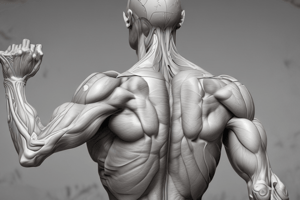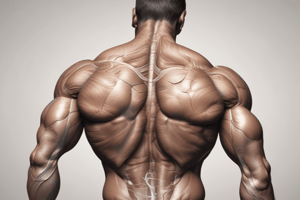Podcast
Questions and Answers
Which of the following muscles is responsible for the medial rotation of the arm?
Which of the following muscles is responsible for the medial rotation of the arm?
- Subscapularis (correct)
- Supraspinatus
- Infraspinatus
- Teres Minor
The temporalis muscle is primarily involved in closing the eye.
The temporalis muscle is primarily involved in closing the eye.
False (B)
Which muscle is responsible for the abduction of the arm?
Which muscle is responsible for the abduction of the arm?
Supraspinatus
The occipito-frontalis muscle is responsible for raising the eyebrows and wrinkling the ______.
The occipito-frontalis muscle is responsible for raising the eyebrows and wrinkling the ______.
Match the following muscles with their action:
Match the following muscles with their action:
All of the following muscles insert on the humerus EXCEPT:
All of the following muscles insert on the humerus EXCEPT:
The rotator cuff muscles help keep the head of the humerus closely connected to the socket of the scapula.
The rotator cuff muscles help keep the head of the humerus closely connected to the socket of the scapula.
Which two muscles listed are primarily responsible for mastication (chewing)?
Which two muscles listed are primarily responsible for mastication (chewing)?
Flashcards
Subscapularis
Subscapularis
Muscle responsible for medial rotation of the arm originating from the scapula and inserting on the front of the humerus.
Teres Minor
Teres Minor
Muscle that performs lateral rotation of the arm; originates from the back of the scapula and inserts on the back of the humerus.
Infraspinatus
Infraspinatus
Muscle responsible for lateral rotation of the arm, originating from the back of the scapula and inserting on the back of the humerus.
Supraspinatus
Supraspinatus
Signup and view all the flashcards
Temporalis
Temporalis
Signup and view all the flashcards
Masseters
Masseters
Signup and view all the flashcards
Occipito-frontalis
Occipito-frontalis
Signup and view all the flashcards
Orbicularis Oculi
Orbicularis Oculi
Signup and view all the flashcards
Study Notes
Rotator Cuff Muscles
- The rotator cuff muscles (subscapularis, infraspinatus, teres minor, supraspinatus) keep the humerus head closely connected to the scapula socket
- These muscles are important for proper shoulder function, similar to ligaments in the hip
Shoulder Muscles: Actions
- Subscapularis: Medial rotation of the arm
- Supraspinatus: Abduction of the arm, and helps with lifting the arm
- Infraspinatus: Lateral rotation of the arm
- Teres Minor: Lateral rotation of the arm
Face Muscles
- Temporalis: Mastication (chewing)
- Masseters: Mastication (chewing)
- Occipito-frontalis: Raises eyebrows, wrinkles forehead, and moves scalp
- Orbicularis oculi: Closes the eye
- Orbicularis oris: Closes the mouth
Additional Notes
- The temporal bone and the mandible are important parts for mastication.
- The zygomatic arch is also involved in mastication.
- The tendons over the scalp are important for eyebrow movement.
- The rim of the eye socket is critical for eye movement.
- Sphincter muscles around the mouth allow for lip movements.
Studying That Suits You
Use AI to generate personalized quizzes and flashcards to suit your learning preferences.



